This text was obtained via automated optical character recognition.
It has not been edited and may therefore contain several errors.
14 METAIRIE: A Tongue of Land to Pasture object of veneration to the Savages but at the same time I cannot stifle a groan on seeing that it is really futile, for, even within sight of this salutary cross, many of these poor blind people will perish miserably through lack of knowing its virtue. By 1705 the Colapissas were living on the northern shore of Lake Pontchartrain and in the following year Penicaut spent an idyllic winter vacation with them and the Nassitoches Indians. The two tribes were then on amicable terms, due to the efforts of Louis Juch-ereau de St. Denis, an original settler on Bayou St. John and, later, founder of Natchitoches. Penicaut’s description of the Colapissas’ religious customs as he observed them in 1706 points to their continuing adherence to the same pagan worship and superstitious practices as Father du Ru had noted. After Father du Ru, at least two other Jesuit missionaries, Father Joseph de Limoges and Father Jacques Gravier had attempted to Christianize the Bayougoula and other Indian tribes settled in the lower Mississippi Valley. The intensive and permanent evangelization of the descendants of these and other Choctaw-related Indians waited another 150 years for the Louisiana naturalist, romanticist, poet, and priest, Father Adrien E. Rouquette (1813-1887). Reared as a youth in his Creole parents’ home on Bayou St. John, near Bayou Sauvage, he would become their Chahta-Ima, “like a Choctaw,” by living with and ministering to them from his hermitage on the northern shore of Lake Pontchartrain. Of the three groups—Choctaws, Colapissas, and Chapitoulas—the Choctaws were the most numerous and kept their identity the longest. To this day, there is a settlement in Lafourche Parish called Choctaw, situated near Thibodaux. In both Louisiana and Mississippi, there are families of Choctaw origin. The ancient name Chapitoulas has endured under the form of Tchoupitoulas in the remnants of a plantation, in a restaurant on the River Road, and in New Orleans’s busiest waterfront corridor. The Colapissas lent their name to a New Orleans and a Jefferson Parish street, each of them a relatively short distance from what the chroniclers called “I’ancien village des Colapissas.” This village may have been centered on the Metairie area where Orleans and Jefferson parishes meet today. Its “main street” undoubtedly was the chemin des Chapitoulas—Metairie Road. V*. CHAPTER THREE Three Chauvin Dubreuil and A fine example for tho. tion belies a land xuhic in it. Father Pierre Fr< Description de la TEN YEARS BEFORE a smugglers cleared land in the s New Orleans, a handful of Fre St. John. They strove to suppl ing colony on the Gulf Coast w Louis Juchereau de St. Denis, v encouraged some Biloxi India group of friendly Indians on h Boulaye just built on the Miss John section shared briefly the ment on the coast, Biloxi. By 1708, five or six coloni: success an arpent1 of land on th< they first concentrated on prod soil nor the damp climate was failure with wheat after two ye* Rivard de Lavigne and Sieur continued to live along the bayc i A front arpent is estimated at 192

Hancock County Early Metairie-a-tongue-of-land-to-pasture-Bezou-1973-(090)